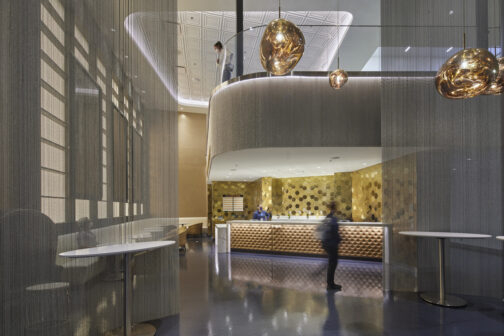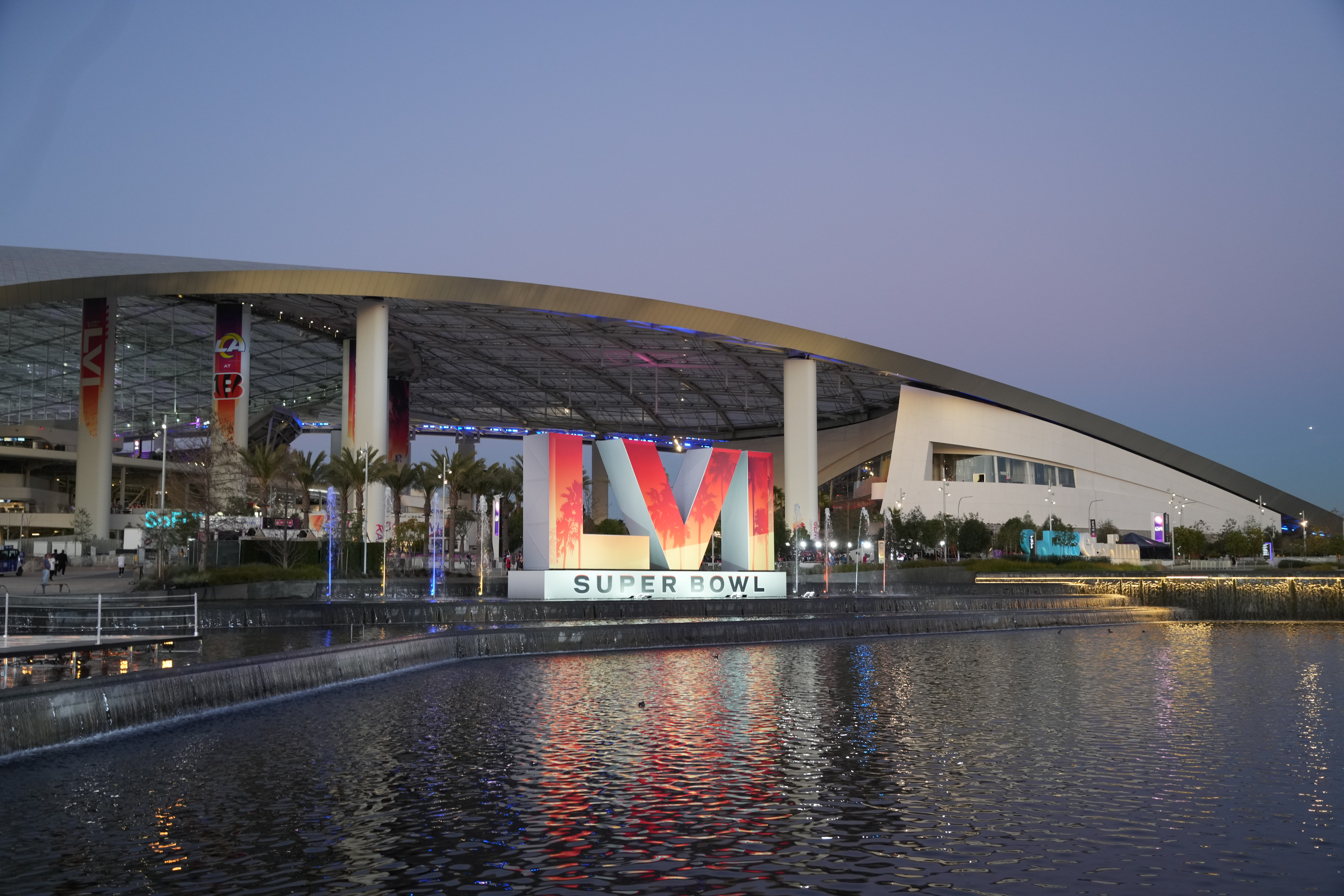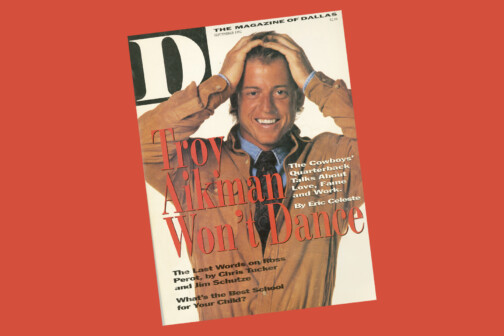The best way to understand how HKS reimagined the NFL stadium might be through sheer tonnage—of acreage and asphalt, glass and steel, brick and mortar. This feels appropriate given the scale of what the Dallas architectural firm has built over the past decade and a half: four boundary-pushing stadiums, each more audacious than the last, where the NFL has chosen to host four of the last 12 Super Bowls.
Or, better yet, you could consider The Champagne Bar.
The Champagne Bar—yes, capitalized—is one attraction within the 75,000-foot Executive Club at SoFi Stadium in Los Angeles, home to the Rams, who will play the Cincinnati Bengals at SoFi in Sunday’s Super Bowl. It is the first of its kind at an NFL venue, designed from its tiles to the light fixtures as a physical representation of the beverage itself. Which is to say it is perfectly L.A., where “probably unnecessary” and “definitely awesome” collide unlike anywhere else in America.
And so, as impressive as the scope is, the secret behind how HKS’s venues have become magnets for Super Bowls—and prize fights and mega concerts and perhaps even World Cup matches come 2026—is in the details that make those buildings germane to their cities.

According to Mark A. Williams, who heads up HKS’ Sports and Entertainment group, each stadium project begins with an 18-month design process. The bedrock is what Williams calls “almost an anthropological analysis of the region,” from the climate to the history to the traffic and beyond. How do a city’s residents spend their money? What’s important to them?
Once they have the answers, HKS gets to work designing the venue that best fits both city and team. Nothing is off the table. After all, as Williams says he told Jerry Jones during the planning of AT&T Stadium, the second of HKS’ four NFL buildings, “The only given is that the field is 100 yards long.”
In Indianapolis, HKS fashioned Lucas Oil Stadium’s exterior from brick trimmed with Indiana limestone, an aesthetic in line with several other venues in the area. The seating bowls were sculpted to accommodate NCAA Tournament basketball, a Hoosier State staple.
At AT&T Stadium—“Probably the one where we really became known globally,” Williams says—it was the Texas-sized video board plus creative seating layouts and price points—like standing room only sections—to accommodate a wider range of customers from one of the largest fanbases in the country.
U.S. Bank Stadium in Minneapolis, home of the Minnesota Vikings, turns heads for being designed like a Nordic ship. Equally important, however, are the slanted roof designed to ward off snow accumulation (this once collapsed the roof at the Metrodome, the Vikings’ previous home) and its placement on the sunny side of the street for extra warmth on frigid winter days.
Then there’s SoFi, HKS’ newest creation and its most glamorous at a reported cost north of $5 billion. Unique though it may be, The Champagne Bar is merely a garnish to the canopy roof; an accompanying 6,000-seat performance center called the YouTube Theater; and the Infinity Screen, which eclipsed AT&T’s video board as the largest in sports by way of 2.2 million pounds and 70,000 square feet of digital LED.
The endgame is four venues that, somehow, tightrope between identifiably HKS—the audacious designs, high-level technology, and liberal use of glass—as well as distinctive. It’s obvious who designed them and equally obvious that there is no template, which is how Williams prefers it.
“Indianapolis, Minneapolis, Dallas, Los Angeles—all very different cities,” he says. That’s why it brings joy to me when somebody [notices] they’re very different looking. They should be. They should function differently. They should act differently.”
Each one has pushed boundaries beyond the last, be it through size, technology, design, or parts of all three. Now the question is what’s next. Not long ago, HKS burst onto a scene dominated by Populus, previously known as HOK, which had designed 13 NFL stadiums with liberal use of concrete blocks and spiral ramps. HKS’ designs were newer and sleeker, which helped usher that previous era into extinction. But in 2022, HKS is the standard-bearer, putting the onus on them to stay on the forefront of the wave they engineered.
Williams has plenty of ideas for how to do so. Technology, for starters, from more interactive and wide-ranging entertainment options all the way to smarter, publicly accessible data gathered from the field—a menu that appeals to casual and hardcore fans alike, to say nothing of the wide spectrum in between. After all, he points out, “That person that’s sitting at home has their TV on, there’s another device going, they’re sending an email, and they’re watching something on the second screen.” The stadium, for better or worse, is the next frontier.
And if the fan experience inside the stadium can be rethought, why not the stadium itself? For generations, the stands have stood apart from concessions and entertainment stations. Williams envisions a more integrated environment. The Champagne Bar? “Maybe that’s fully embedded in the seating bowl,” he muses.
All of which could, he hopes, set the stage for a final evolution: the death of the mixed-use development, the stadium as a center point for other uses located inside it.
“I think that the hard lines between those different building types need to be eradicated,” he says. “The hotel, the retail, the housing, commercial office buildings—you just keep naming the list—I think those should be within and of the sporting venue.”
That seems far-fetched, but HKS didn’t build Super Bowl hubs by playing things conventionally. Almost two decades ago, HKS got into the NFL stadium business through a simple ethos: “We asked every question, again, and some that hadn’t been asked before,” Williams says. And there are so many more left to answer.
Author







